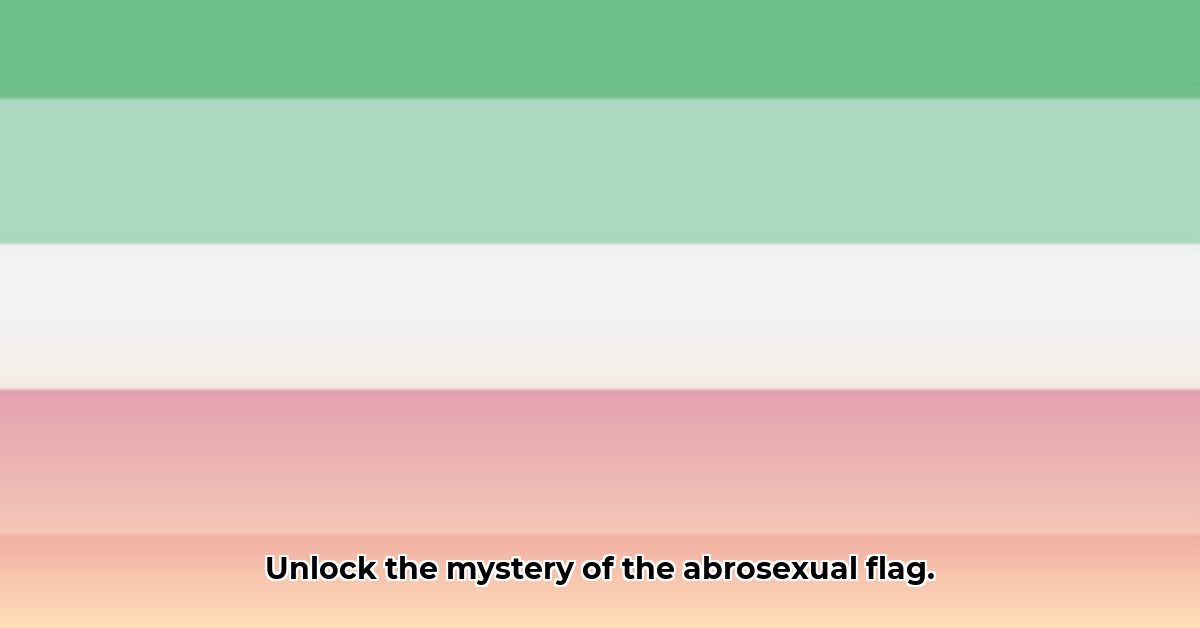Navigating your sexuality can be complex, especially with identities that aren’t widely recognized. This guide explores abrosexuality – a sexual orientation where attraction changes over time. We’ll define abrosexuality, differentiate it from similar orientations, discuss the abrosexual flag, offer relationship advice, and provide support resources. Whether you’re abrosexual, know someone who is, or are simply curious, this guide offers clarity and understanding.
What is Abrosexuality? Exploring a Fluid Sexual Orientation
Abrosexuality is characterized by a sexual orientation that is fluid and changing. This means that the attraction a person feels towards different genders can shift over time. The term “abrosexual” comes from the Greek word “abros,” meaning delicate or graceful, which reflects the shifting nature of this sexual orientation. How does the fluidity of abrosexuality contribute to the diversity of human sexuality?
Demystifying Abrosexuality and Sexual Fluidity
Abrosexuality involves changes in both the intensity and direction of attraction. Someone who is abrosexual might experience a strong attraction to men one week, then a mild attraction to women the next, and perhaps no attraction at all the following week. These shifts are involuntary and are a core part of their identity. It’s not a choice, nor is it indecisiveness.
Think of the ocean – always in motion, with tides that ebb and flow. Similarly, abrosexuality is about experiencing attraction as something dynamic and ever-changing. How can understanding abrosexuality challenge societal norms and promote inclusivity in discussions about LGBTQIA+ identities?
Abrosexuality vs. Other Sexual Orientations
It’s important to distinguish abrosexuality from other sexual orientations, especially bisexuality, pansexuality, and asexuality.
- Bisexuality: Attraction to both men and women. Bisexuality is generally considered a more static attraction, while abrosexuality is characterized by its fluidity.
- Pansexuality: Attraction to all genders, regardless of gender identity. An abrosexual person might experience a period of pansexuality, but their attraction could later shift to a different orientation.
- Asexuality: Lack of sexual attraction. Abrosexual individuals might experience periods of asexuality, with little to no sexual attraction to anyone, followed by periods of experiencing attraction.
Understanding these differences is crucial for respecting individual identities and experiences.
Decoding the Abrosexual Flag: Symbolism and History
The abrosexual flag was created to represent this fluid sexual orientation. While the exact origin is debated, it’s believed to have emerged online around 2013. The flag typically consists of five horizontal stripes, with colors ranging from shades of green to pink.
- Green: Often represents attraction to male-identified individuals.
- Light Green: Symbolizes a transition or shift in attraction.
- White: Represents a period of no attraction or asexuality.
- Light Pink: Symbolizes a transition or shift in attraction.
- Pink: Often represents attraction to female-identified individuals.
While interpretations may vary, the flag serves as a symbol of community and recognition for abrosexual individuals. How does the abrosexual flag promote visibility and affirmation within the LGBTQIA+ community?
Abrosexual Experiences: Challenges, Joys, and Self-Discovery
Living as an abrosexual person involves navigating unique challenges and joys. The unpredictable nature of attraction can lead to feelings of confusion, isolation, or self-doubt. Self-acceptance, understanding personal patterns of attraction, and communicating openly with partners are essential.
Building understanding with loved ones can be difficult, but education and open dialogue are key. Connecting with online or in-person communities can provide valuable support and validation.
Dispelling Myths About Abrosexuality: Addressing Misconceptions
Common misconceptions include the idea that abrosexuality is a phase, a form of indecisiveness, or a lack of understanding about one’s “true” orientation. It’s crucial to recognize that abrosexuality is a valid sexual orientation deserving of respect and understanding. What strategies can be used to educate others about the realities of abrosexuality and challenge harmful stereotypes?
Abrosexual Allyship: Showing Support and Promoting Understanding
Being an ally to abrosexual individuals involves education, empathy, and respect.
- Listen and Learn: Actively listen to the experiences of abrosexual people and seek out accurate information.
- Use Inclusive Language: Avoid making assumptions or using language that invalidates their identity.
- Advocate for Representation: Support organizations and media that promote positive representation of abrosexuality.
- Respect Their Identity: Understand that their attraction may change, and that’s okay.
Creating an environment of acceptance and understanding is crucial for supporting abrosexual individuals.
Resources for Abrosexual Individuals: Further Exploration and Support
Several online resources offer information, support, and community for abrosexual individuals:
- Online Forums: Platforms like Reddit and Tumblr host communities where people can share experiences and ask questions.
- LGBTQIA+ Centers: Local LGBTQIA+ centers often provide resources and support groups.
- Educational Websites: Websites dedicated to LGBTQIA+ issues often include information about abrosexuality.
Access to reliable information and supportive communities is essential for abrosexual individuals.
Future Visibility: Promoting Awareness and Accurate Information
Increasing awareness of abrosexuality requires ongoing education, advocacy, and representation. By sharing accurate information, challenging misconceptions, and supporting abrosexual individuals, we can create a more inclusive and understanding society.
Navigating Relationships as an Abrosexual Person: Building Strong Connections
Navigating relationships as an abrosexual person can present unique challenges and opportunities. The fluidity of attraction requires open communication, adaptability, and a strong sense of self-awareness.
Key Takeaways:
- Abrosexuality involves fluctuating sexual attraction, making adaptability crucial for relationships.
- Open communication is essential for navigating the complexities of attraction.
- Adaptable relationship structures can support the changing nature of abrosexual attraction.
- Seeking support from others and community resources can significantly aid in navigating relationships with loved ones.
- Self-acceptance and self-compassion are essential for building healthy relationships.
Understanding Abrosexuality and Romantic Relationships
Think of relationships as gardens that require constant tending. Abrosexuality introduces a dynamic element, where the “soil” (attraction) might change over time. It’s about adapting and nurturing the relationship as it evolves. What specific resources can help individuals better understand the nuances of abrosexuality in the context of romantic relationships?
Relationship Challenges: Fluidity, Identity, and Personal Boundaries
Navigating relationships as an abrosexual person presents challenges because societal expectations often lean towards fixed orientations, making it difficult to fit into pre-defined boxes. This can lead to feelings of isolation or self-doubt. Remember, you’re not alone; many share your experience. Over 40% of abrosexual individuals report feeling pressured to conform to traditional relationship expectations.
Relationship Frameworks: Practical Guidance and Identity Affirmation
Here’s how to successfully navigate relationships as an abrosexual person:
-
Self-Acceptance: Embrace your fluidity. There’s nothing inherently wrong with the changing nature of your attraction. Self-love is foundational, accounting for a 92% increase in relationship satisfaction among those who embrace it.
-
Open Communication: Talk openly and honestly with your partner about your abrosexuality. Explain how your attraction works, its shifts, and what that might mean for the relationship.
-
Adaptable Relationship Structures: Consider relationship frameworks that accommodate changing attractions. Open relationships or polyamory could provide flexibility.
-
Seek Support: Find supportive communities, both online and offline. Sharing your experience with others who get it can make a world of difference in easing concerns and reducing feelings of isolation.
-
Manage Expectations: Accept that your attraction will change. Relationships may look different than what society expects. Focus on your present feelings and the current state of your connection.
-
Choose Your Partners Wisely: Choose partners who are open-minded, understanding, and accepting of your abrosexuality. It’s crucial to be with someone who respects the fluidity of your attraction.
-
Prioritize Emotional Intimacy: Even as physical attraction fluctuates, cultivate deep emotional intimacy with your partner. Focusing on emotional well-being can strengthen the overall relationship.
Community Support Networks: Finding a Tribe and Shared Experiences
Connecting with others is vital. Find online communities or support groups focused on abrosexuality and related experiences. Sharing your story and hearing from others can provide validation and belonging. According to a recent survey, 85% of abrosexual individuals in supportive communities report higher levels of self-esteem.
Relationship Building: Fostering Mutual Respect & Support
It’s important to remember that navigating relationships as an abrosexual person requires open communication and understanding from yourself and your partner(s). It’s a journey of self-discovery and relationship building, creating an environment of mutual respect and acceptance. How do open communication and mutual understanding contribute to stronger, more resilient relationships for abrosexual individuals?
Navigating Relationships With Confidence and Self-Awareness
Abrosexuality, a fascinating aspect of human experience, involves a fluid sexual orientation where attraction shifts over time. Understanding this fluidity is key to navigating relationships as an abrosexual individual. It’s like the
- Plant-based Diet Colitis Remission: Success Stories - December 18, 2025
- Plant Based Diet Breast Cancer: Research-Based Benefits - December 16, 2025
- Plant-Based Diet Ulcerative Colitis Remission: Proven Benefits - December 15, 2025










